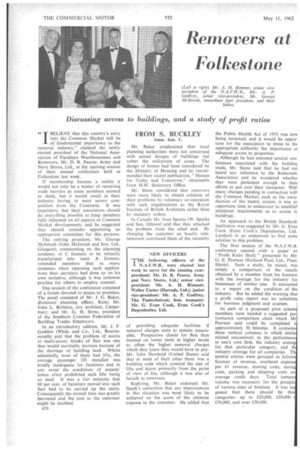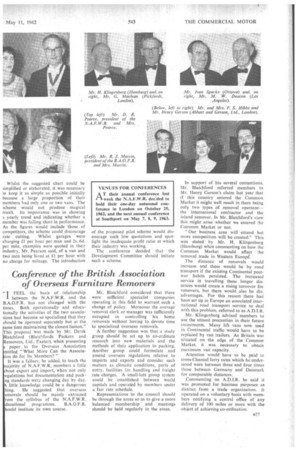Removers at Folkestone
Page 52

Page 53

If you've noticed an error in this article please click here to report it so we can fix it.
Discussing access to buildings, and a study of profit ratios
FROM S. BUCKI,EY
Assoc. Inst. T.
64
I
BELIEVE that this country's entry
into the Common Market will be of fundamental importance to the removal industry," claimed the newly elected president of the National Association of Furniture Warehousemen and Removers, Mr. D. R. Pearce, Army and Navy Stores, ,Ltd., at the opening session of their annual conference held at Folkestone last week.
If membership became a reality it would not only be a matter of removing trade barriers as some members seemed to think, but it would result in their industry having to meet severe competition from the Continent. It was imperative that their association, should do everything possible to keep members fully informed on all aspects of Common Market developments, and he suggested they should consider appointing an appropriate committee for this purpose.
The retiring president, Mr. George McIntosh (John McIntosh and Son, Ltd., Glasgow), commenting on the alarming tendency of C licences to be virtually transformed into open A licences, reminded members that in many instances when opposing such applications their secretary had done so on his own initiative, although it was common practice for others to employ counsel.
One session of the conference consisted of a forum devoted to access to premises. The panel consisted of Mr. J. G. Baker, divisional • planning officer, Kent; Mr. John L. Berbiers, city architect, Canterbury; and Mr. G. Fl. Stone, president of the Southern Counties Federation of Building Trades Employers.
In an introductory address, Mr. J. F. Godden (White and Co., Ltd., Bournemouth) said that the problem of access to multi-storey blocks of flats was one that would inevitably increase because of the shortage of building land. Whilst admittedly most of them had lifts, the average passenger lift installed was totally inadequate for furniture and in any event the conditions of tenants' leases often prohibited such lifts being so used. It was a fair estimate that 60 per cent. of furniture moved into such flats had to be carried up the stairs. Consequently the overall time was greatly increased and the cost to the customer might be doubled.
B26 Mr. Baker emphasized that local planning authorities were not concerned with actual designs of buildings but rather the utilization of areas. The design of homes had been considered by the Ministry of Housing and he recommended their recent publication, " Homes for Today and Tomorrow," obtainable from H.M. Stationery Office.
Mr. Stone considered that removers were more likely to obtain solution of their problems by voluntary co-operation with such organizations as the Royal Institute of British Architects rather than by statutory orders.
In Canada Mr. Ivan Sparks (W. Sparks and Son, Ottawa) said that they attacked the problem from the other end. By charging the customer an hourly rate, removers convinced them of the necessity
of providing adequate facilities if removal charges were to remain reasonable. Prospective clients for flats then insisted on lower rents at higher levels to offset the higher removal charges which they knew they would have to pay. Mr. John Newbold '(United States) said that in most of their cities there was a building code which covered the size of lifts and doors primarily from the point of view of fire, although it was also of benefit to remover:.
Replying, Mr. Baker endorsed Mr. Spark's contention that any improvement in this situation was most likely to be achieved on the score of the ultimate expense to the customer. He added that
the Public. Health Act of 1953 was novi being reviewed, and it would be opportune for the association to stress to thc appropriate authority the importance oJ adequate access to properties.
,Although he had attended several con, ferences associated with the buildini trade, Mr. Stone said that he had nal heard any reference to the Removers Association and he wondered whethei they were persistent enough in theii efforts to put over their viewpoint. Witt many changes pending in connection witt the Common Market, such as the intro' duction of the metric system, it was ar opportune time to endeavour to establist minimum requirements as to access tc buildings.
An approach to the British Standardi Institution was suggested by Mr. G. Evan Cook (Evan Cook's Depositories. Ltd. London) in an endeavour to find some solution to this problem.
The final session of the N.A.F.W.R conference opened with a paper on "Profit Ratio Study presented by Mr. G. E. Pearson (Richard Pool, Ltd., Fleet Hants). Such a study, he stated, wa.E simply a comparison of the result obtained by a member from his businesi with the average for the industry foi businesses of similar size. It amounted to a report on the condition of the industry. But he added the warning that a profit ratio report was no substitut for business judgment and acumen.
As part of a proposed pilot schem members were handed a suggested per formance comparison chart which Mr Pearson said could be completed i approximately 30 minutes. It containe three vertical columns in which entrie related successively to the performanc in one's own firm, the industry averag for that particular category, and th industry average for all companies. Th several entries were grouped as follow Sources of revenue, overhead expens per £1 revenue, moving costs, storag costs, packing and shipping costs an average credit days. Total turnov volume was necessary for the groupin of various sizes of business. It was su gested that there should be thr categories: up to £20,000, £20,000 £50,000, and over £50,000.
Whilst the suggested chart could be iimplified or elaborated, it was necessary lo keep it as simple as possible initially because a large proportion of their members. had only one or two vans. The scheme would not produce magical result. Its importance was in showing 3. yearly trend and indicating whether a member was falling short in performance. As the figures would include those of competitors, the scheme could discourage rate cutting. Whilst garages were charging El per hour per man and 2s. 6d. per mile, examples were quoted in their industry, Mr. Pearson said, of a van and two men being hired at LI per hour with no charge for mileage. The introduction of the proposed pilot scheme would discourage such lbw quotations and spotlight the inadequate profit ratio at which their industry was working.
The conference decided that the Development Committee should initiate such a scheme.




































































































